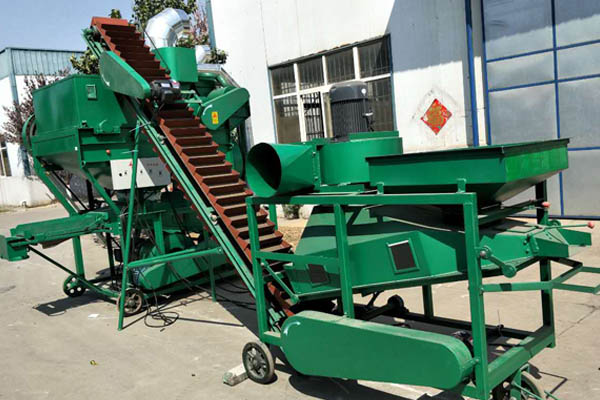How to use the peanut shelling machine
The utilization of peanut shelling machines is becoming increasingly popular among farmers. However, some individuals are not able to fully optimize the machine’s capacity due to a lack of proficiency in its operation. This can result in poor performance with low efficiency and an increased risk of worker injury. As such, it is imperative to understand how to properly use the peanut shelling machine. In this regard, the author would like to provide a professional guide on the correct usage of the machine to ensure optimal performance and safety.

1. Working principle of peanut shelling machine
Peanut shelling machine consists of machine frame, fan, rotor, single-phase machine, sieve cloth (big and small), feeding hopper, vibration sifter, groove pulley and the driving belt. After the machine is in normal operation, a certain amount of peanut should be feed into the hopper evenly and continuously. Under the repeated hitting, friction and striking force of rotor, the peanut are crushed. The crushed granule and shell pass through the sifter with a certain aperture under the rotating and hitting force of rotor( for the first time, the sifter with the big whole are used, then the small kernel and shell are selected by the sifter with small holes), and they are filtered and separated. Under the blowing force of fan, the shell and kernel are separated. The peanut shells with light weight are blown out of the machine, while the kernel with heavy weight has been selected through the vibration sifter.
2. Requirement for the right way of using peanut shelling machine
1). The requirement for the peanut shelling machine. The machine should has clean shelling, high efficiency and are equipped with the cleaning device with high degree of cleaning; low loss rate, small breaking rate; simple structure, reliable, easy to adjust, less energy consumption and a certain kind of universality. It can be used for shelling of varied crops, to improve the utilization rate of machine.
2). The requirement for the peanut (with shell). The peanut should be not too dry or too wet. If they are too dry, the breaking rate is high; if they are too wet, it will affect the work efficiency. There are several ways to get the proper moisture content of material.
(1).shelling in winter. Before shelling, use about 10kg warm water to spread on about 50kg peanut, and cover the peanut with plastic film( in other season, 6 hours for covering is ok). Then put the peanut under the sunshine for drying about 1 hour before shelling.
(2). put the drying peanut into the water pond, fish out them after soaking, then cover the peanut by plastic film for about one day. Then put the peanut under the sunshine for drying, shelling the peanut before they are proper in moisture content.
3. Proper Usage and Maintenance Guidelines for a Peanut Sheller
Pre-Operation Inspection
Before using a peanut sheller, it’s crucial to perform a thorough inspection of the machine. Check all fastening parts to ensure they are secure and examine the rotating components for flexibility. Additionally, make sure that lubrication points have enough oil.
Motor Operation and Direction
Once the motor is running normally, ensure that the direction of the rotor aligns with the machine’s indicated direction. After letting the machine idle for a few minutes, carefully listen for any abnormal sounds. If everything is in order, you can begin feeding peanuts into the machine evenly.
Proper Peanut Feeding
When feeding peanuts into the sheller, ensure that they are distributed evenly and in an appropriate quantity. Avoid including any materials such as iron scraps or stones to prevent damage to the peanuts and potential mechanical accidents. Only open the discharging mouth when the sifter is entirely covered with peanuts.
Sifter Selection
Select the appropriate sifter based on the size of the peanuts you are processing. This ensures efficient separation of peanut shells from the kernels.
Adjusting the Motor Position
As the peanut shell accumulates in the kernel, you may need to adjust the motor’s position downward to tighten the fan belt. This adjustment increases the blowing capacity, aiding in the separation process.
Safety Precautions
During operation, it’s essential for workers to avoid standing near the driving belt’s path to prevent accidents and injuries. Safety should always be a top priority when using any machinery.
Post-Operation Cleaning and Storage
After using the peanut sheller for a period of time, it’s crucial to clean the machine thoroughly. Remove dust, dirt, and any remaining peanut pellets or residues from the chamber. Unpack the belt for storage in a separate location. Use diesel oil to clean each bearing thoroughly and apply grease to keep them lubricated. Finally, store the machine in a dry warehouse to protect it from rain and direct sunlight, which can cause damage over time.
Regular Maintenance
To ensure the long-term performance of your peanut sheller, routinely check and maintain the driving components and bearings. Ensure they have enough oil, and replace any worn-out or damaged parts promptly. Regular maintenance is essential for preventing breakdowns and extending the machine’s lifespan.
KMEC is a professional producer of peanut machine, which includes peanut shelling machine, peanut roaster, peanut peeling machine, half kernel machine and sifter. If you have any requirements, please feel free to contact with us.
